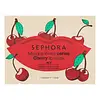What's inside
What's inside
 Key Ingredients
Key Ingredients

 Benefits
Benefits

 Concerns
Concerns

No concerns
 Ingredients Side-by-side
Ingredients Side-by-side

Water
Skin ConditioningDipropylene Glycol
HumectantMethylpropanediol
SolventGlycerin
Humectant1,2-Hexanediol
Skin ConditioningNiacinamide
SmoothingPanthenol
Skin ConditioningAllantoin
Skin ConditioningEthylhexylglycerin
Skin ConditioningTheobroma Cacao Seed Extract
AntioxidantCentella Asiatica Leaf Extract
Skin ConditioningAsiaticoside
AntioxidantMadecassic Acid
Skin ConditioningAsiatic Acid
Skin ConditioningButylene Glycol
HumectantPolyglyceryl-4 Oleate
EmulsifyingSodium Stearoyl Glutamate
CleansingPalmitoyl Tripeptide-8
Skin ConditioningPolyglyceryl-10 Laurate
Skin ConditioningCarbomer
Emulsion StabilisingTromethamine
BufferingIsopentyldiol
HumectantPropanediol
SolventXanthan Gum
EmulsifyingDextrin
AbsorbentSodium Surfactin
CleansingDextran
Citric Acid
BufferingSodium Phytate
Hydroxyacetophenone
AntioxidantCI 19140
Cosmetic ColorantCI 42090
Cosmetic ColorantWater, Dipropylene Glycol, Methylpropanediol, Glycerin, 1,2-Hexanediol, Niacinamide, Panthenol, Allantoin, Ethylhexylglycerin, Theobroma Cacao Seed Extract, Centella Asiatica Leaf Extract, Asiaticoside, Madecassic Acid, Asiatic Acid, Butylene Glycol, Polyglyceryl-4 Oleate, Sodium Stearoyl Glutamate, Palmitoyl Tripeptide-8, Polyglyceryl-10 Laurate, Carbomer, Tromethamine, Isopentyldiol, Propanediol, Xanthan Gum, Dextrin, Sodium Surfactin, Dextran, Citric Acid, Sodium Phytate, Hydroxyacetophenone, CI 19140, CI 42090
Hydroxyethylcellulose
Emulsion StabilisingCaprylic/Capric Triglyceride
MaskingBetaine
HumectantDipotassium Glycyrrhizate
HumectantXanthan Gum
EmulsifyingParfum
MaskingPrunus Cerasus Fruit Extract
AntioxidantSodium Benzoate
MaskingCitric Acid
BufferingPanthenol
Skin ConditioningUndaria Pinnatifida Extract
Skin ConditioningPotassium Sorbate
PreservativeDisodium Phosphate
BufferingPolysorbate 60
EmulsifyingCI 17200
Cosmetic ColorantSodium Phosphate
BufferingWater
Skin ConditioningCellulose
AbsorbentScutellaria Baicalensis Root Extract
AstringentGlycyrrhiza Uralensis Root Extract
Skin ConditioningDextrin
AbsorbentZiziphus Jujuba Fruit Extract
Skin ConditioningAstragalus Membranaceus Root Extract
EmollientHydroxyethylcellulose, Caprylic/Capric Triglyceride, Betaine, Dipotassium Glycyrrhizate, Xanthan Gum, Parfum, Prunus Cerasus Fruit Extract, Sodium Benzoate, Citric Acid, Panthenol, Undaria Pinnatifida Extract, Potassium Sorbate, Disodium Phosphate, Polysorbate 60, CI 17200, Sodium Phosphate, Water, Cellulose, Scutellaria Baicalensis Root Extract, Glycyrrhiza Uralensis Root Extract, Dextrin, Ziziphus Jujuba Fruit Extract, Astragalus Membranaceus Root Extract
 Reviews
Reviews

Alternatives
Ingredients Explained
These ingredients are found in both products.
Ingredients higher up in an ingredient list are typically present in a larger amount.
Citric Acid is an alpha hydroxy acid (AHA) naturally found in citrus fruits like oranges, lemons, and limes.
Like other AHAs, citric acid can exfoliate skin by breaking down the bonds that hold dead skin cells together. This helps reveal smoother and brighter skin underneath.
However, this exfoliating effect only happens at high concentrations (20%) which can be hard to find in cosmetic products.
Due to this, citric acid is usually included in small amounts as a pH adjuster. This helps keep products slightly more acidic and compatible with skin's natural pH.
In skincare formulas, citric acid can:
While it can provide some skin benefits, research shows lactic acid and glycolic acid are generally more effective and less irritating exfoliants.
Most citric acid used in skincare today is made by fermenting sugars (usually from molasses). This synthetic version is identical to the natural citrus form but easier to stabilize and use in formulations.
Read more about some other popular AHA's here:
Learn more about Citric AcidDextrin is used to thicken a product and helps bind ingredients together. It is created from starch and glycogen.
As an emulsifier, dextrin prevents ingredients from separating. This helps elongate a product's shelf life.
Studies show coating UV filters with dextrin prevents these ingredients from being absorbed. This helps UV ingredients last longer on the skin.
Learn more about DextrinPanthenol is a common ingredient that helps hydrate and soothe the skin. It is found naturally in our skin and hair.
There are two forms of panthenol: D and L.
D-panthenol is also known as dexpanthenol. Most cosmetics use dexpanthenol or a mixture of D and L-panthenol.
Panthenol is famous due to its ability to go deeper into the skin's layers. Using this ingredient has numerous pros (and no cons):
Like hyaluronic acid, panthenol is a humectant. Humectants are able to bind and hold large amounts of water to keep skin hydrated.
This ingredient works well for wound healing. It works by increasing tissue in the wound and helps close open wounds.
Once oxidized, panthenol converts to pantothenic acid. Panthothenic acid is found in all living cells.
This ingredient is also referred to as pro-vitamin B5.
Learn more about PanthenolWater. It's the most common cosmetic ingredient of all. You'll usually see it at the top of ingredient lists, meaning that it makes up the largest part of the product.
So why is it so popular? Water most often acts as a solvent - this means that it helps dissolve other ingredients into the formulation.
You'll also recognize water as that liquid we all need to stay alive. If you see this, drink a glass of water. Stay hydrated!
Learn more about WaterXanthan gum is used as a stabilizer and thickener within cosmetic products. It helps give products a sticky, thick feeling - preventing them from being too runny.
On the technical side of things, xanthan gum is a polysaccharide - a combination consisting of multiple sugar molecules bonded together.
Xanthan gum is a pretty common and great ingredient. It is a natural, non-toxic, non-irritating ingredient that is also commonly used in food products.
Learn more about Xanthan Gum